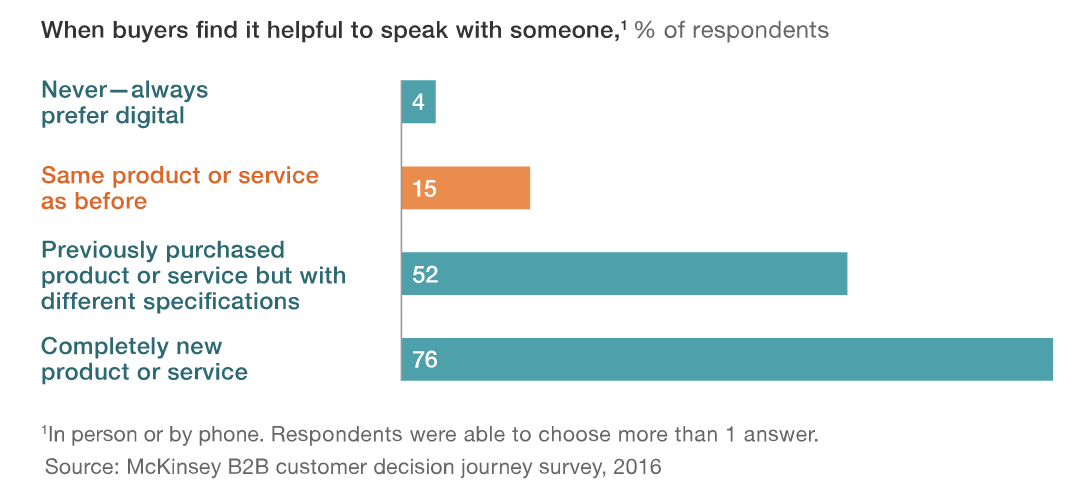 I’m half way through facilitating the redesign of key customer journeys across a particular b2b lifecycle.
I’m half way through facilitating the redesign of key customer journeys across a particular b2b lifecycle.
As you might imagine new purchasing behaviours and online competitors have made the search for a viable business model something of an urgency. One that these days is most often summarised as needing to become a ‘digital first’ business.
We had an interesting cross section of experience in the workshops; helping articulate what we imagined were the priorities for both key account and non key account customers.
This was synthesised from group discussions between face to face account managers, phone and chat advisors, digital transformation consultants, website designers, digital marketers and customer experience leaders.
A series of follow up workshops with invited customers will then challenge this ‘inside-out’ perspective: adding the customer voice on how ‘jobs to be done’ should work and verify what really matters for a successful outcome.
I picked up a few gems while orchestrating the debate. Mainly around how parochial our specialist viewpoints can become, mine included.
We get used to a set of assumptions around how things should work which is reinforced in our daily work within our own know how tribes.
For instance, I found myself dragged into defending points of view I usually consider givens while at the same time trying to figure out where the other point of view was coming from.
The whole experience reminded me of the role of context and its influence on our mindset and priorities.
For instance, the sum total of my life experiences has resulted in me gravitating towards the commonality between people rather than the differences. I’m an experiential ‘join the dots’ kind of person.
In customer journey mapping this translates into me zoning in on what matters to everyone and making sure design, implementation and ongoing governance nail these universal experiences.
Whereas a ‘digital’ mindset I’ve now discovered, is conditioned to seek out the differences between the personas. Ideally fed by a real time stream of customer data for crafting personalised journeys.
Both perspectives are in fact looking at the same thing. Mine emphasises common needs such as choice and low effort task completion. The ‘digital’ architect sees unique events driven by distinct needs.
So we got into debates about the number of variables we really needed to factor into the new web site design brief.
Did each persona really need a separately designed journey? Or was the behaviour common across personas and the difference lay in the relevance of content e.g. stuff they wanted to buy?
It took some time to realise we were using the same language to mean different things.
Digital versus Omni Channel
The other insight I gained from these debates was a further example of how personal context influences design thinking.
For me it goes to the heart of my issue around any ‘digital first’ strategy. Again it’s all to do with the strengths and weaknesses of your own know how.
Mine is that I come from a human to human engagement background.
I learnt my trade during a time when prospects were visited or at least expected phone based interaction in real time with another person in order to buy something or get something fixed.
Much of my time these days is spent educating when and how to use self service and refocus live interaction where it’s most valuable – situations that are emotional, complex or require relationship investment.
However I’m grounded in the notion that it’s the interplay and optimisation between live assistance and self service that results in better outcomes for both brand and customer.
Digital starts from a different assumption.
As an intentionally catalytic force, digital first strategies inevitably adopt a certain reforming zeal. Out with the old. In with the new world of algorithmic ‘next best actions’ or whatever version of non manual substitution is being proposed.
In my world, omni channel is the context for a design decision. One that includes offline and online. As such, digital is just one of my engagement choices. Albeit an incredibly important one in a ‘software is eating everything’ world.
In a digital first world, digital is everything. Live assistance is bolted on as a fail safe option e.g. the typical web chat facility, rather than being engineered into the journey, based on a deeper insight into when humans need humans.
Here’s another example.
A new global b2b CMO cancels a programme of brand sponsored thought leadership workshops in favour of a digital only approach to pipeline development.
Is she being smart or blind to what it takes to be noticed and appreciated in an incredibly noisy IT marketplace? Is face to face now an unecessary luxury?
Bearing in mind this is a post about b2b customers, here is recent research from McKinsey that suggests we make better design decisions when omni channel acts as our context instead of a digital only agenda
“B2B suppliers cannot choose between a great sales force and great digital assets and capabilities. To drive growth, they need both.”
Why?
It all depends on what the customer is wanting to do. 
In this case it’s live assistance to start with. Then smart self service thereafter once a familiar purchasing pattern is established.
This insight shows that the search for a new business model in b2b markets has to maintain a human based salesforce albeit honed to its maximum value; without being wasted on administrative and simple, non complex information provision which digital solutions are born for.
To that end, I’ve no doubt intelligent assistants with their conversational interfaces will be in the thick of it; bridging the experience of offline and online worlds.
It is a combined strategy as opposed to a replacement one we really need.
In which case, it’s time to retire ‘digital by default’ on the grounds of being misleading and instead embrace the more accurate description of aiming for ‘omni-channel by default’.
It’s what the evidence is telling us.




